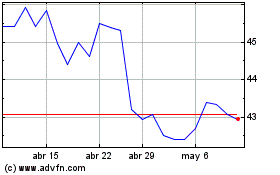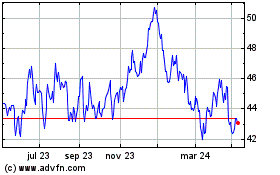Train Stopping: BHP Derails Runaway Locomotive From 800 Miles Away
06 Noviembre 2018 - 12:13AM
Noticias Dow Jones
By Rhiannon Hoyle
SYDNEY--It sounds like a plot from a movie: a train carrying
tons of cargo barreling out of control and a mission to stop
it.
But for BHP Billiton Ltd. it was real life, as four locomotives
and 268 loaded wagons ran loose for more than 50 miles without a
driver.
Monday's journey was meant to be a regular rail movement from
BHP's iron-ore mines in Western Australia's Pilbara region, where
temperatures can top 100 degrees Fahrenheit in summer and vast
distances separate communities. But when the driver disembarked to
inspect one of the wagons loaded with ore, the train wasn't
properly secured and began to roll away.
It took off, and traveled about 57 miles in 50 minutes.
With the train out of control and headed toward Port Hedland, on
Australia's west coast, operators some 800 miles away in Perth took
action. Using remote sensors to switch points at an isolated part
of the Outback, they forcibly derailed the train in the desert
without anyone being hurt.
In a statement, BHP said it was working to recover the rogue
train from the desert some 75 miles from the coast--action that
could take up to a week.
Still, the derailment disrupted the company's operations and led
to a 2.3% jump in iron-ore prices Monday as traders bet on reduced
supply of a key ingredient in steelmaking. BHP suspended all of its
rail operations while the circumstances that led to the train
running loose are investigated by the Australian Transport Safety
Bureau.
The derailment comes amid heightened scrutiny of BHP's safety
record since a deadly spill at its Samarco iron-ore venture with
Vale SA in Brazil in late 2015. The disaster led Brazilian
prosecutors to file a claim against BHP and its partner for several
billions of dollars, among other lawsuits. BHP and Vale have agreed
to settle some claims.
The Pilbara region accounts for roughly half of all iron ore
traded by sea, with most of the cargoes feeding China's
industrialization. BHP is the region's second-largest producer of
the commodity, after Rio Tinto PLC.
Global miners have been spending heavily to remove the human
factor from a complex supply chain spanning thousands of miles
across continents, part of a program to save billions of dollars
and cushion profits against swings in commodity prices. That
spending has included setting up remote operations centers far from
mines where staff can monitor everything from trucks, drills and
conveyor belts on giant screens and control them at the touch of a
button.
For some companies, automated trains are the next big
innovation. Rio Tinto PLC last month said it is using more
automated trains in the Pilbara and expects to have all of its
iron-ore trains operating without a driver on board by the end of
this year.
BHP is taking a more patient approach to the technology, as it
worries about congestion on the more than 800-mile rail network
that it operates in the Pilbara. While it is using lasers to
automate the track, it hasn't given a timeline on how long it will
be before it uses driverless trains.
Write to Rhiannon Hoyle at rhiannon.hoyle@wsj.com
(END) Dow Jones Newswires
November 06, 2018 00:58 ET (05:58 GMT)
Copyright (c) 2018 Dow Jones & Company, Inc.
BHP (ASX:BHP)
Gráfica de Acción Histórica
De Mar 2024 a Abr 2024

BHP (ASX:BHP)
Gráfica de Acción Histórica
De Abr 2023 a Abr 2024
